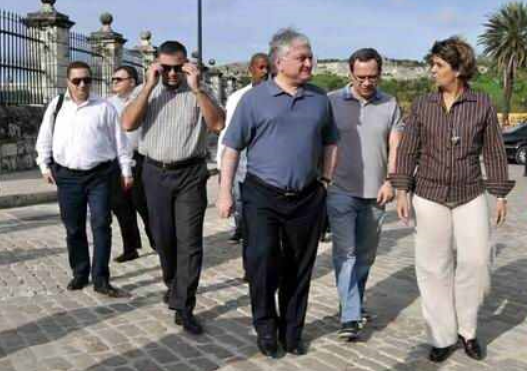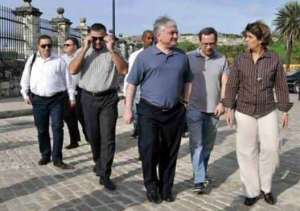
Armenian official seeks broader trade with Cuba
Armenian Foreign Minister Edward Nalbandian on Sunday (Jan. 12) ended a four-day official visit to Cuba that sought to broaden trade relations with the island.

During his visit, Nalbandian met with Cuba’s Minister of Foreign Trade and Investment, Rodrigo Malmierca Díaz; Foreign Minister Bruno Rodríguez Parrilla; Ana MarÌa Machado, vice chairman of the National Assembly, and other functionaries.
A reception in his honor at the Foreign Ministery drew about 50 foreign ambassadors. Nalbandian’s was the first trip to Cuba by an Armenian foreign minister since 2002, when Vartan Oskanian visited the island. Armenia and Cuba established diplomatic relations on Aug. 27, 1992.
Nalbandian arrived in Havana from Panama, where he met with Foreign Minister Fernando Núñez Fábrega. Earlier in the week, he had been in Peru, for talks with Foreign Minister Eda Rivas Franchini.
According to the Armenian news agency Regnum, Malmierca Díaz said that Nalbandian’s visit should “give new impetus to bilateral relations and cooperation in a multilateral format. Nalbandian, in turn, stressed that his visit [was] aimed at strengthening friendly relations and identifying new areas of cooperation.”
Malmierca invited Armenia to participate in the Havana International Fair (FIHAV) in the fall and said Cuba would be pleased to allocate an area for the Armenian pavilion, free of charge.
RodrÌguez Parrilla told his guest that “Cuba is willing to deepen cooperation with Armenia in the political, economic and other spheres. The two sides discussed the joint steps needed to expand cooperation in trade, the economy, health care, education, science and culture,” Regnum reported.
Rodríguez mentioned the possibility of expediting visas for Armenian citizens in an effort to attract tourists to the island from that country.
Although a trade agreement has existed since March 2003, trade between the two countries is minimal and heavily weighted on the side of Armenia, which imports mostly alcoholic beverages and tobacco from Cuba.
Armenia’s imports from Cuba in 2009 totaled 52,600 dollars; in 2010, $165,200, and in 2011, $66,100, according to the Armenian Foreign Ministry, which has released only partial figures for 2012 and 2013.
During the ministerial talks, Rodríguez thanked Nalbandian for Armenia’s support at the United Nations for Cuba’s complaint against the United States’ trade blockade. Nalbandian thanked Rodríguez for Cuba’s support for Armenia in its dispute with the Republic of Azerbaijan over the Nagorno-Karabakh region, whose independence Armenia recognizes.
Situated in the South Caucasus region of Eurasia, Armenia is at the crossroads of Western Asia and Eastern Europe. It is bounded by Turkey to the west, Georgia to the north, Azerbaijan and Nagorno-Karabakh to the east, and Iran to the south.
Between 1920 and 1991, Armenia was one of the socialist republics that made up the Soviet Union. It became independent on Sept. 21, 1991. Its current president is Serzh Sargsyan.
For an account (in Spanish) of Nalbandian’s visit, in the Cuban daily Granma, click here.
For an account (in Spanish) in the website of the Cuban Foreign Ministry, click here.

